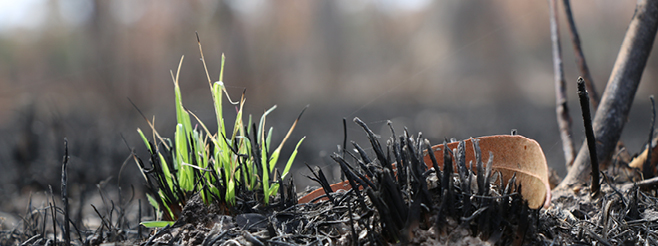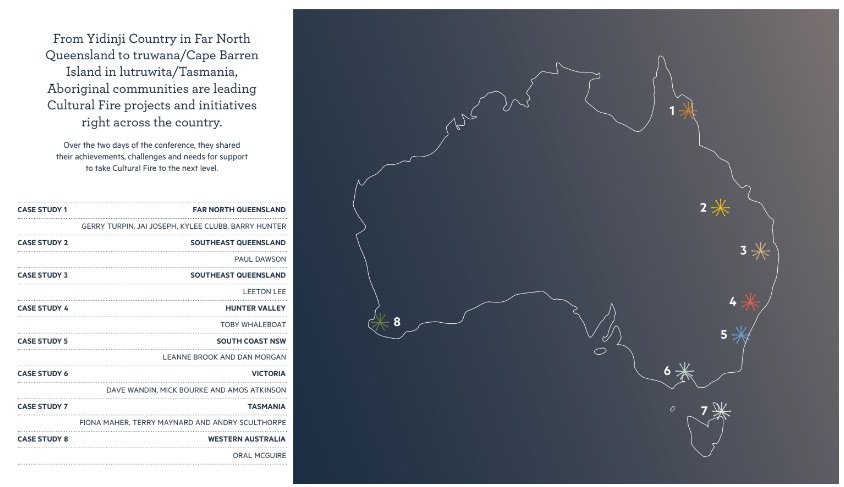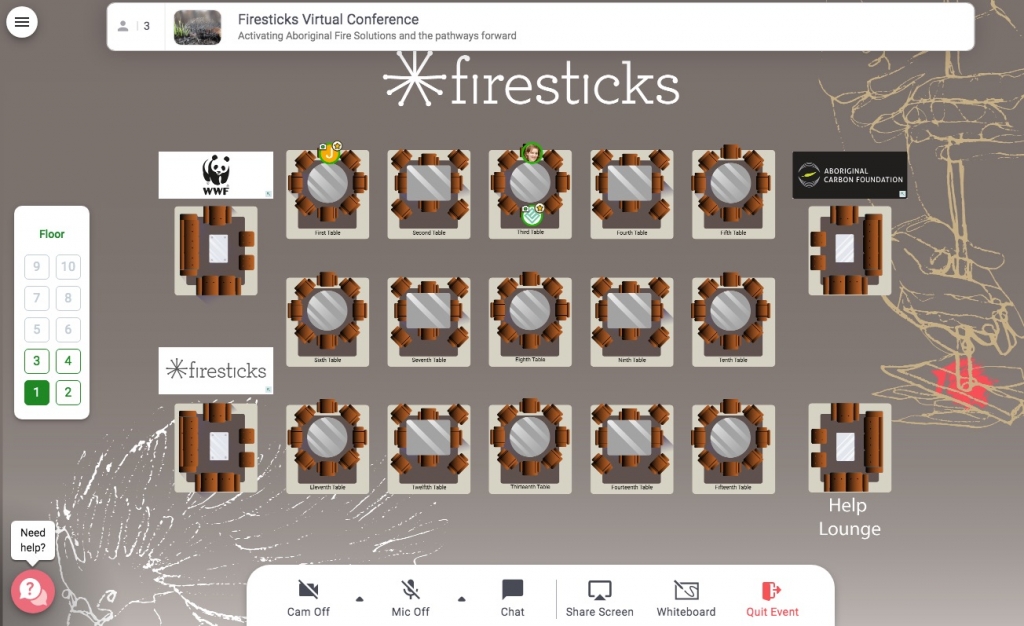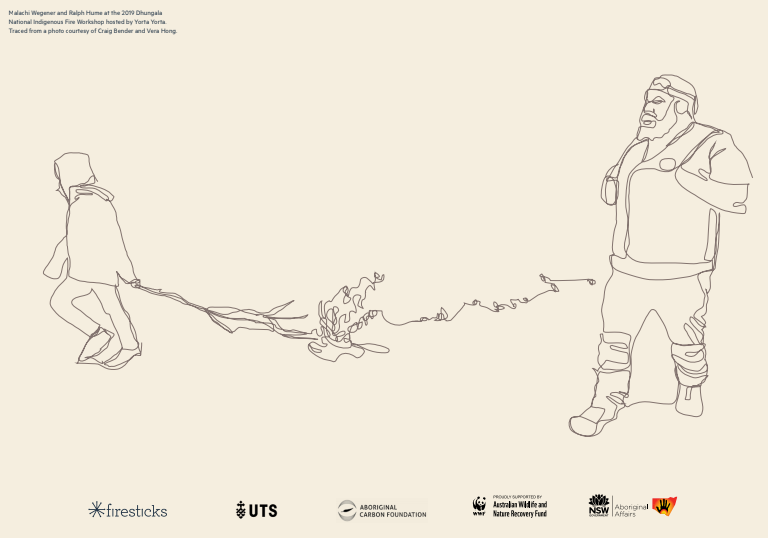
Kuku Thaypan Country Cape York Peninsula. Photo courtesy of Leo Goddard.
From Noongar Country in Western Australia to lutruwita/Tasmania, over 170 people gathered online for the Firesticks Virtual Conference 2020.
The purpose of the virtual conference was to keep the connection and momentum growing across Cultural Fire practitioner groups who were unable to gather face-to-face due to the COVID-19 pandemic. The virtual conference also provided an important opportunity for communities to provide insights and feedback on the Firesticks Alliance’s next steps.
For more detail, make sure to read the Conference report here
or watch more videos from the Conference here.
Why online?
Once it became clear that the 2020 National Indigenous Fire Workshop would have to be postponed, Firesticks decided to explore virtual event options. Soon after, Indigenous event production company Dreamtime Event Productions approached Firesticks with a new digital event technology that they had developed.
This event interface promised a more interactive experience between conference attendees than a standard digital event. Digital events usually only have a chat box for attendees to type into, whereas Dreamtime Productions’ interface would allow attendees to sit at ‘tables’ with each other, where they could have video conversations, document breakout discussions using digital ‘whiteboards’, as well as type questions to panellists and presenters through a standard chatbox.
The online event format and the carefully curated program was a hit with participants.
According to Nat Burke, Senior Manager, Social Development at WWF-Australia: “I’ll be honest – at first I was pretty skeptical about the idea of an online conference. Others that I have attended have just been a series of extended zoom calls. Yet Firesticks found a way to curate a program that really felt like a bunch of people having a yarn. It felt like a genuine opportunity for groups, who are separated by thousands of kilometers and perhaps haven’t engaged with each other that much, to share. And I think conferences generally don’t create enough of that sort of space.”
A series of daily email updates – titled “Our stories” – were also produced to raise awareness of the key conference topics, themes and outcomes that delegates may otherwise have missed. You can read these by clicking the links below:
Connecting to Country digitally
Gathering together in ceremony to honour and connect to the Country on which we meet is a vital part of any Firesticks workshop or conference. Being online for the Firesticks Virtual Conference presented a unique opportunity to honour and connect to multiple places where communities are bringing back good fire.
“To make fire, we start with the energy of our bodies. We collect firesticks off Country so that we become a part of Country. Fire and smoke is very important to our people. When we feel like we need to connect to Spirit, we sit around the fire. In Gimuy (Cairns), wunyju bayal (smoking ceremony) is the most relevant and practiced ceremony for our people. We have lost many ceremonies, but this one seems to have never gone anywhere. The connection to fire, smoke and family through this ceremony will never go away.”
Carl Fourmile, Yidinji man from the land of Gimuy in Far North Queensland, conducting a wunyju bayal (smoking ceremony) and Lynton Schreiber, Yarrahbah man from Gunggandji plays the Didgeridoo during the Welcome to Country on Day 1 of the Firesticks Virtual Conference 2020.
“We stand strong and proud in honour of our Ancestors. We acknowledge our Elders who have gifted us the knowledge. We acknowledge our Elders past, present and those to emerge.”
Sinsa Mansell, Trawoolaway women from larapuna the Northern region of lutruwita/Tasmania leads pakana kanaplila dance group’s Welcome to Country in nipaluna/Hobart to open Day 2 of the Firesticks Virtual Conference 2020.
Cultural Fire gaining national attention
The virtual conference opened with introductory remarks from Victor Steffensen from the Firesticks Alliance. He spoke about how the 2020 wildfires has seen Cultural Fire getting a voice on a national scale, with conservation and land management agencies starting to support First Nations peoples’ leadership in managing Country into the future.
“We’re calling on state and commonwealth agencies, universities, all communities, private landholders and their representative farming bodies, everyone across the sector to work together,” Victor said.
“We want to see more employment for all the Aboriginal people managing landscapes. We want to see traditional knowledge taught in schools. We want to see Aboriginal people monitoring, collecting data and doing their own research to deliver Cultural Fire to the world, proudly from Indigenous knowledge and proudly from the communities of Australia.”
Sharing Community Cultural Fire achievements
Over the two days of the conference, representatives from Aboriginal communities across Australia shared their achievements and challenges leading Cultural Fire projects and initiatives, and what support they need to take Cultural Fire to the next level.

Read all the Community Case Studies in the Conference report here.
While each community has a unique story, there were many similar lessons shared – from taking the time to educate and build trust with partners, to the many different and creative ways that communities have overcome the many bureaucratic challenges to practicing Cultural Burning.
For example, Paul Dawson, General Manager of the Bunya People’s Aboriginal Corporation (BPAC) shared their success in building a community of practice founded in healing Country and strengthening Songlines around the highly significant Bonye Biar-Bunya Mountains in southeast Queensland.
Key to overcoming the many bureaucratic hurdles was receiving Cultural Fire mentorship and training from Victor Steffensen, which “opened up the doors of understanding of reading Country and really gave our team a lot of confidence to put the foot down and demand more of a leadership role,” Paul said.
In another case study, Leanne Brook – a proud Murramarang Yuin woman from the Dhurga language group – shared how the community quickly adapted when plans for a series of burns and Cultural Fire Forum unfortunately had to be put on hold because of COVID-19. Instead, they produced a six week webinar series – djamanj djamaga ganj (we talk good fire) – to share knowledge and experience from local Cultural Fire projects.
“We need to build up our people to do the work that Country is calling out for us to do,” Leanne said.
Partners put their shoulders behind Aboriginal Fire leadership
In a partners session, panellists shared the growing interest from agencies to better understand Cultural Burning and to support Firesticks and Traditional Owners to grow the practice of Cultural Burning.
For example, Shane Brown from the Queensland Fire and Emergency Service shared how the fire services need to do more to enable traditional burning methods.
“For every door that we do we open, there’s two more behind it. It shouldn’t be this hard…we need to take the barriers [to Cultural Burning] away so our partners can move forward,” he said.
As the enthusiasm grows, Nat Burke from WWF-Australia pointed out that it’s important that Cultural Burning be led by Aboriginal people.
“All of Australia can benefit from Cultural Fire but it won’t work if it is not Indigenous-led. [Partnerships have to be conducted] in a meaningful way. That requires us to spend more time, build relationships and be genuine. This is not work we can lead,” he said.
Re-igniting memories of Cultural Fire: Strong women lead the way
Participants also heard about the work taking place all across Australia to better support women to fulfil their important roles in Cultural Fire – from being caretakers of women’s-only areas and plants, to teachers and role models to inspire the next generation to care for Country.
For example, Vanessa Cavanagh – a proud Bundjalung and Wonnarua Aboriginal woman – shared preliminary outcomes of her PhD research, which has shown that when Aboriginal women spend more time on Country there is increased monitoring of Aboriginal heritage sites and wider land management issues.
“We know that Country is healthier with people on it,” she said.
Yarning Circles
In the afternoon on both days of the conference had participants split up into breakout groups, or Yarning Circles, enabling them to discuss some of the topics in more detail and use virtual whiteboards to document takeaway messages from those discussions.
On Day 1 participants discussed how to improve Firesticks’ mentoring, training and certification program, which is being restructured to enable more Aboriginal community members to have the skills, confidence and qualifications to practice Culture Fire as well as assure agencies and investors that Cultural Fire practitioners are looking after Country the right way. This would then enable sustainable income streams to support Aboriginal communities on the ground.
The Yarning Circle on Day 2 saw participants provide feedback on the concept of Cultural Fire Credits, which aims to increase independent investment to communities to support the growing practice of Cultural Fire. Participants discussed the best case scenario for Cultural Burns, the investment that would be needed to support this, possible concerns with the Cultural Fire Credit approach, and what some of the social, environmental and cultural benefits might look like.
Reflections
Feedback from participants was overwhelmingly positive, with 100% of survey respondents reflecting that the event increased their knowledge of communities working in Cultural Fire management practice and of the work that Firesticks is doing to support those communities.
“Mekmatyn. Wonderful to be part of the discussion. This has been good medicine. Keep up the good work on country. Cisysimeaj.”
Yes! your program is a fantastic example for all of us – I talk about it all the time in my federal meetings as a great example of Indigenous leadership in fire!
Thanks to everyone who made this event happen and those who have attended. It has been such a pleasure to hear all the deadly voices, stories and work we are all doing. Well done, lots more to do. We’ve got this!!”
Building a strong national network in 2021
As the importance of Cultural Fire becomes increasingly recognised, Firesticks is focused on facilitating the development of a strong national network of professional Cultural Fire practitioners who are fully trained, accredited, certified and well-resourced to practice Cultural Fire across the nation.
We are well on our way to achieving this aim. This year, aspiring Cultural Fire practitioners from Local Aboriginal Land Councils and Traditional Owner organisations across the Hunter region will be able to participate in a first-of-its-kind Cultural Burn program while completing a Certificate 3 to Diploma in Conservation and Land Management at Tocal College.
Working alongside Firesticks’ certification framework that will deliver mentoring and training in Cultural Fire over four years, these courses will serve as a model for scaling up Cultural Fire training and accreditation to other communities in the years to come.

Vanessa Cavenagh with Jarjum (her children), Tyson and Emma Cavanagh at the 2019 National Indigenous Fire Workshop, Dhungala hosted by Yorta Yorta. Photo courtesy of Craig Bender and Vera Hong.
This year will also see Firesticks and the Aboriginal Carbon Foundation launch the Cultural Fire Credit, providing an avenue for the wider community and investors to channel sustainable, long-term and independent investment directly to Aboriginal communities to support Cultural Fire practices.
With so much shared energy and focus in the Firesticks Alliance network, 2021 promises to be a busy year. A special thanks to all who participated in the Firesticks Virtual Conference 2020 and to all the partners, sponsors and team behind the scenes who made the event happen.
Read more in the Firesticks Virtual Conference 2020 report here
or watch more videos from the Conference here.
Thank you
Firesticks Alliance would like to extend our sincere thanks and gratitude to the many people who contributed to the Firesticks Virtual Conference 2020.
We would like to acknowledge our partners and supporters who helped ensure that this year’s conference was such a successful event. Thank you to our investment partner WWF-Australia through the Australian Wildlife & Nature Recovery Fund, supporting partners Aboriginal Carbon Foundation and University of Technology, Sydney, and supporter Aboriginal Affairs NSW. We would also like to thank event producers Dreamtime Event Productions and platform creators Virtual Events.
We pay our respects to the Kuku Thaypan Elders, the late Dr George Musgrave and the late Dr Tommy George, with Victor Steffensen, Mulong for their fire knowledge.



